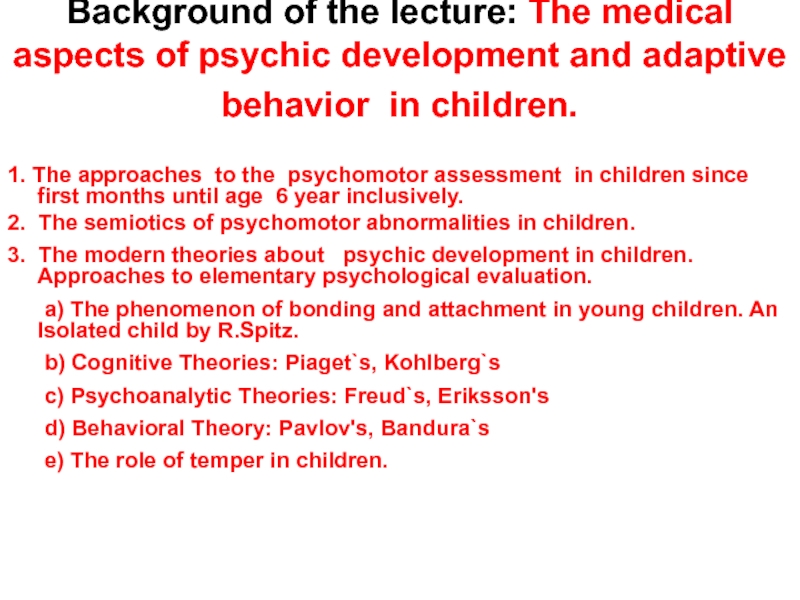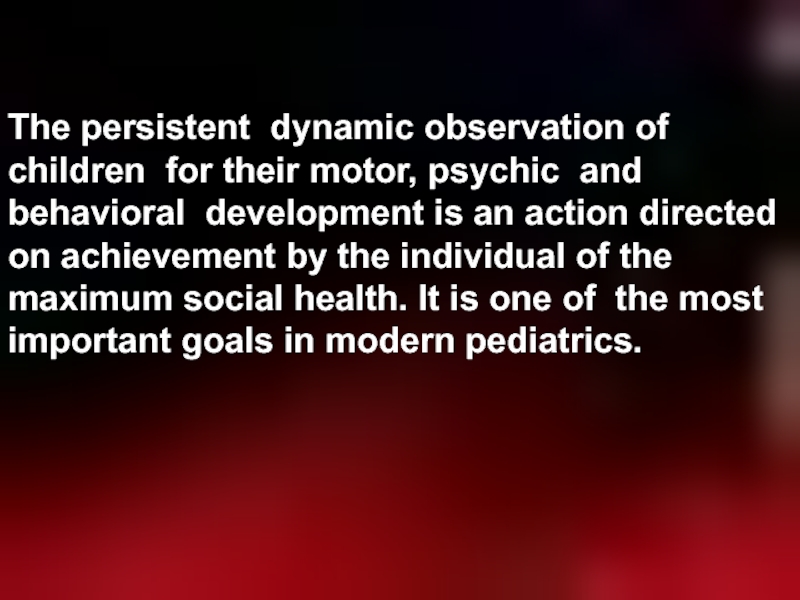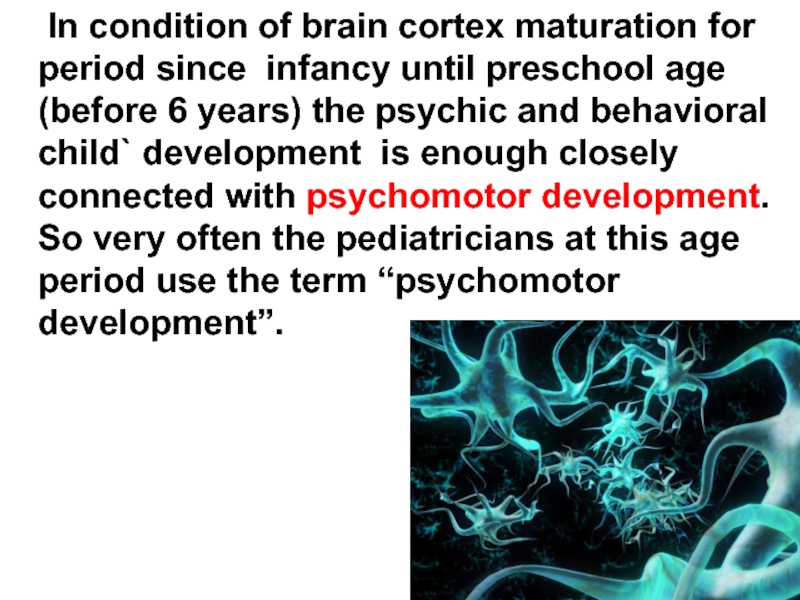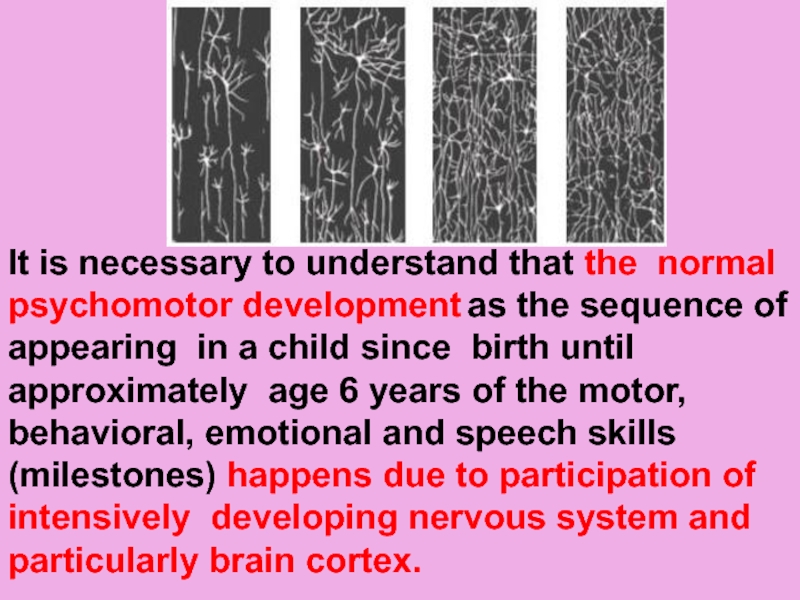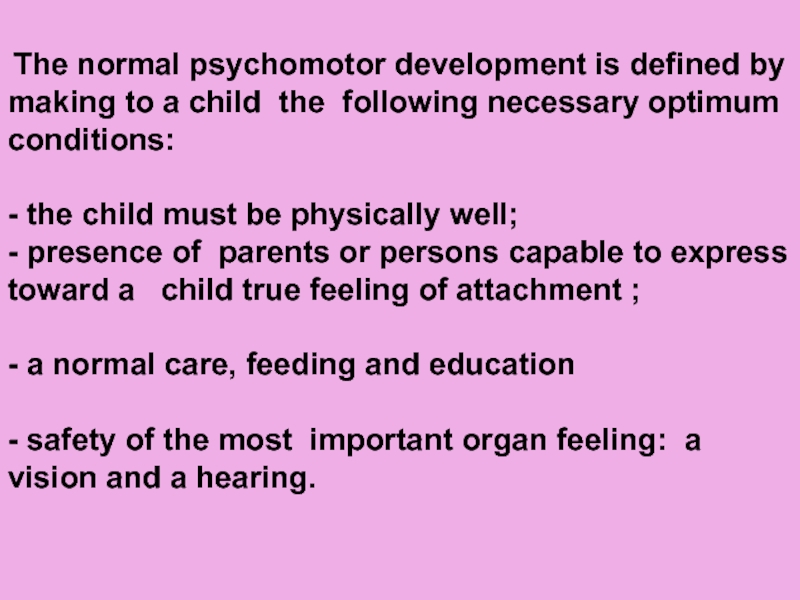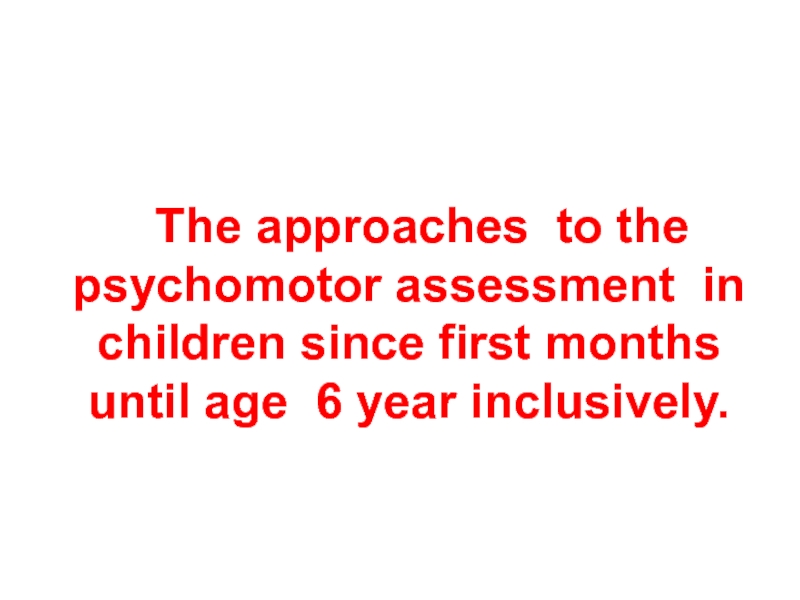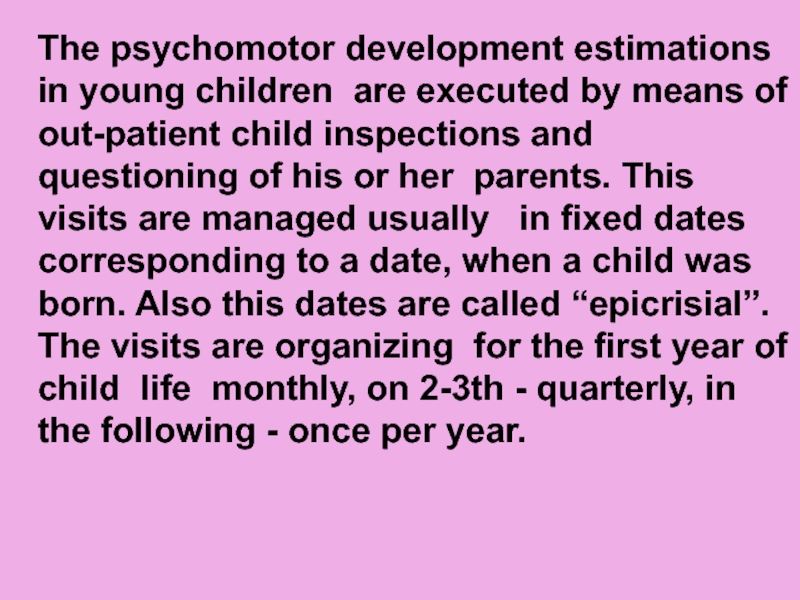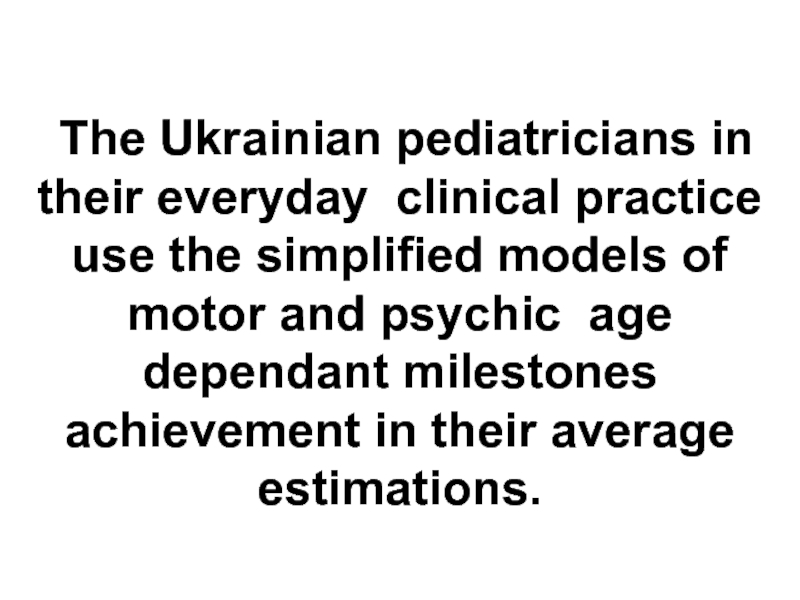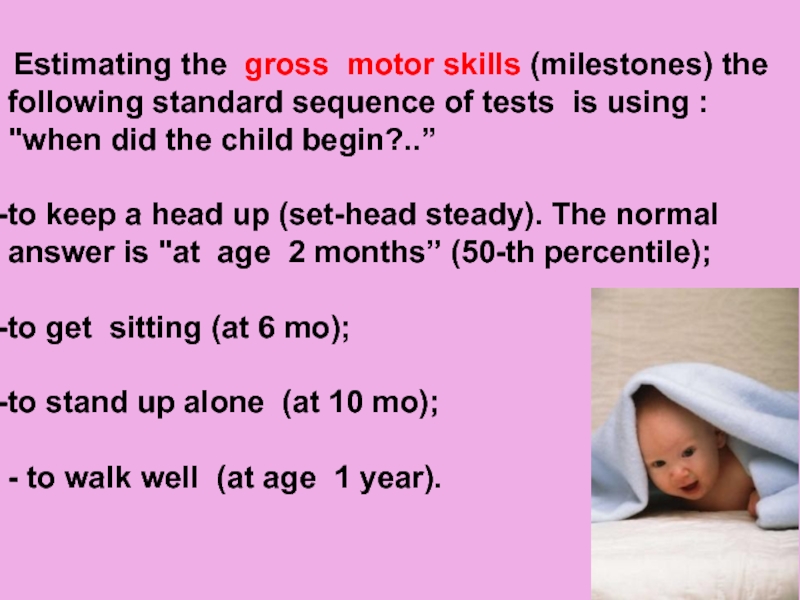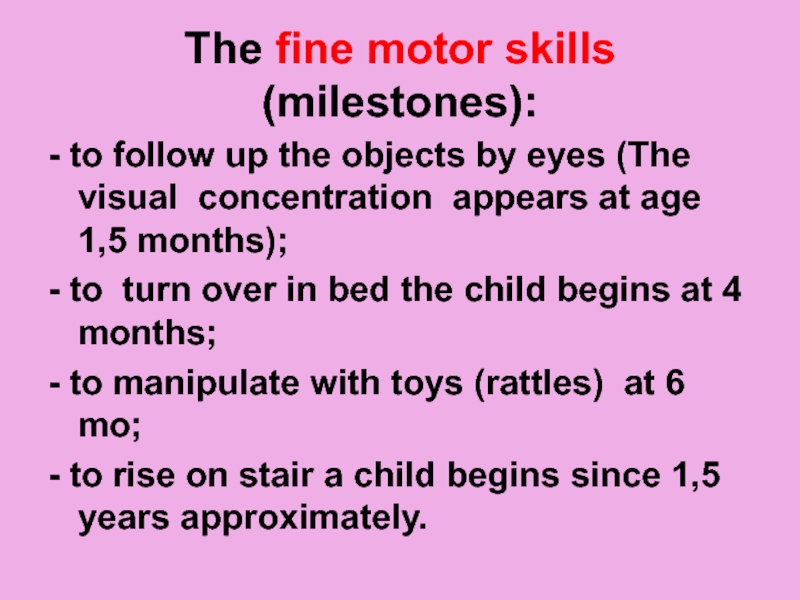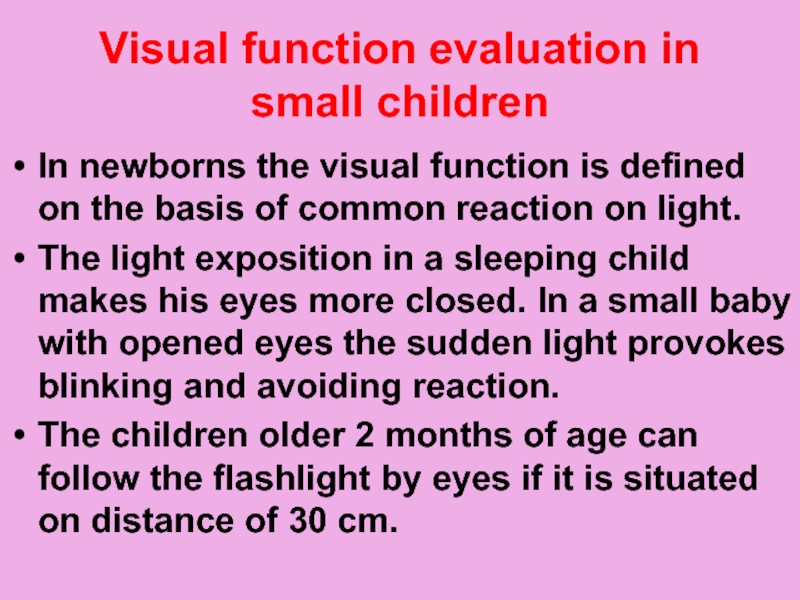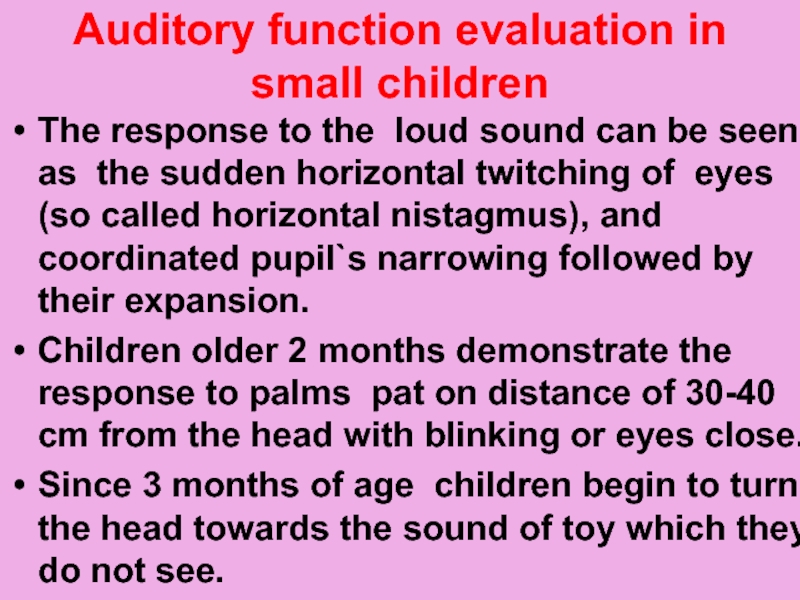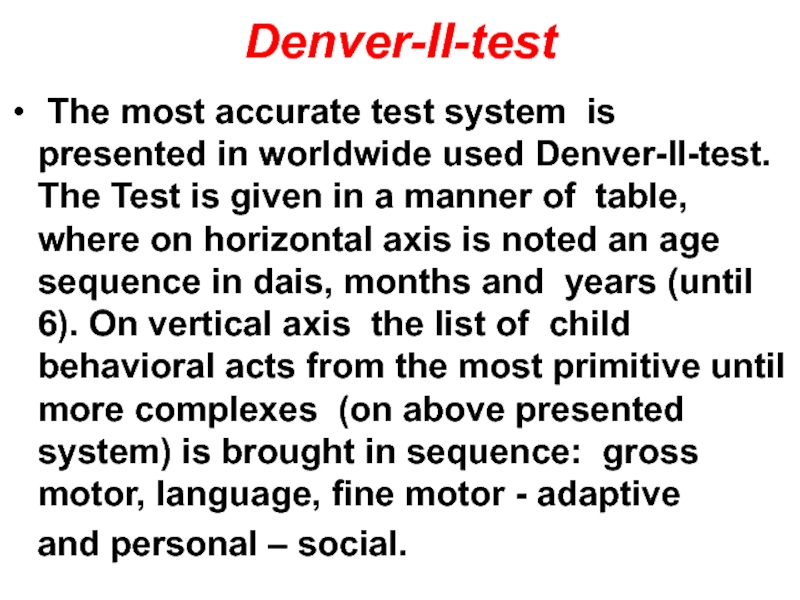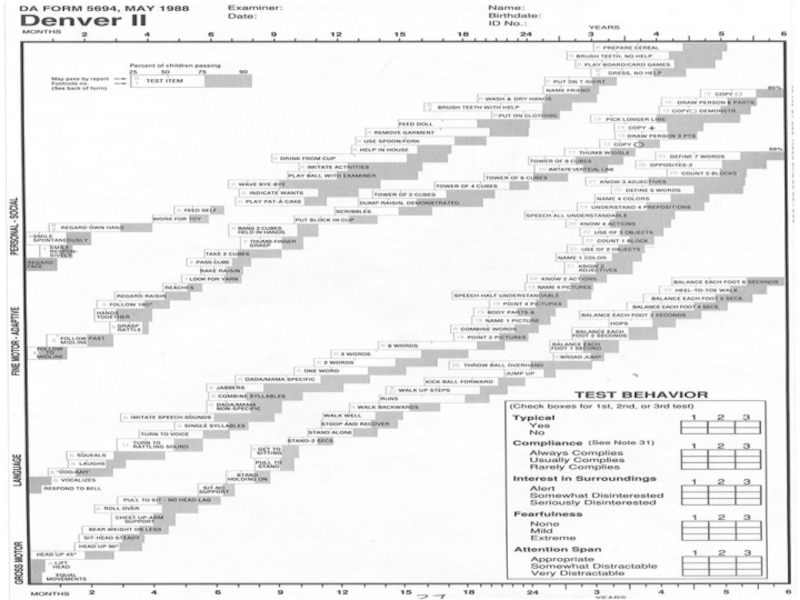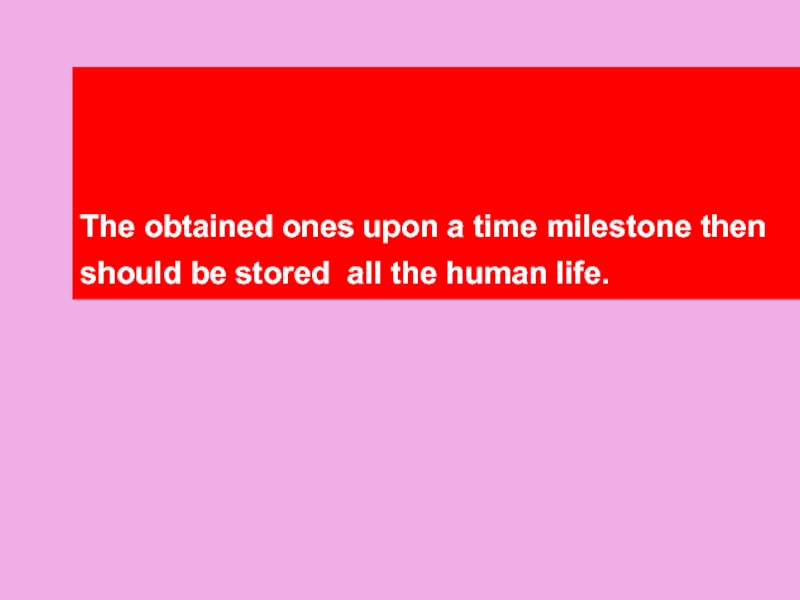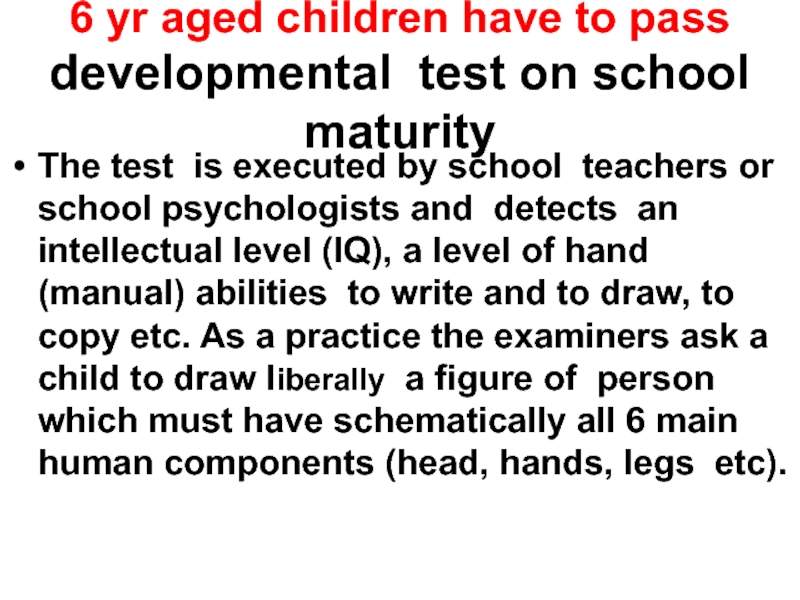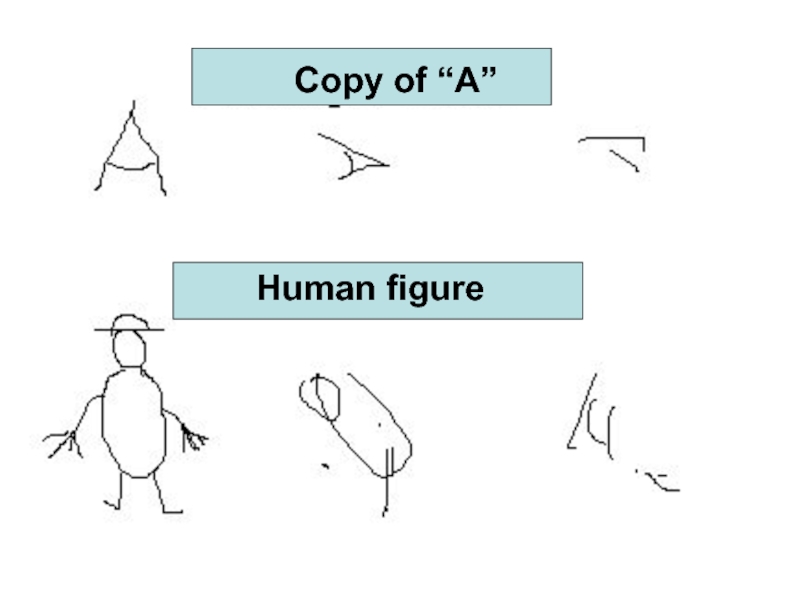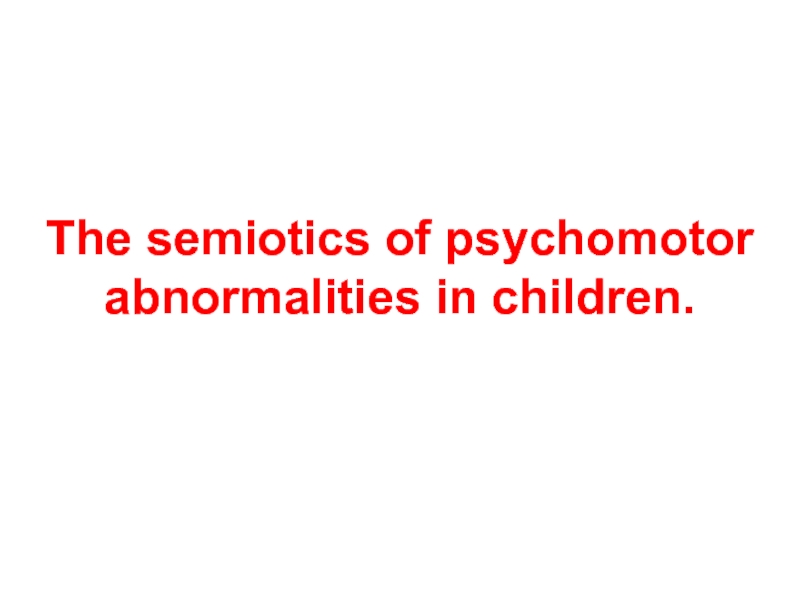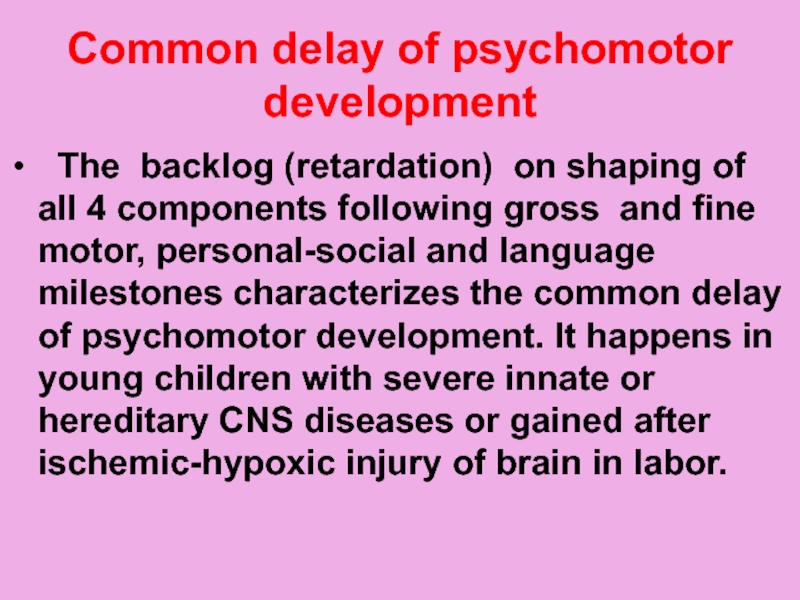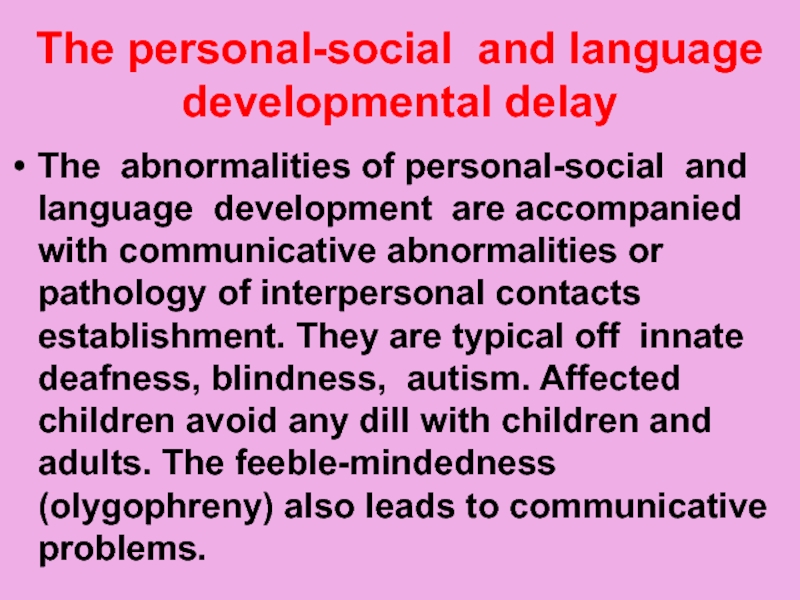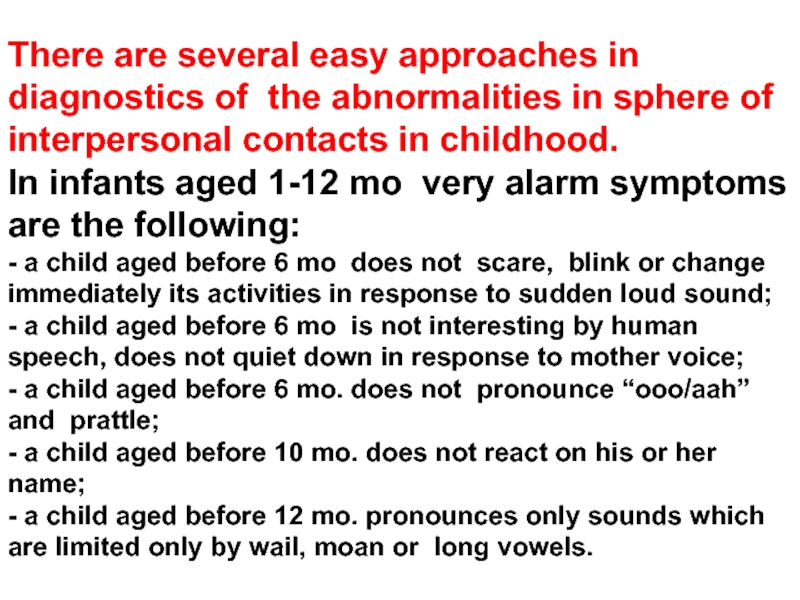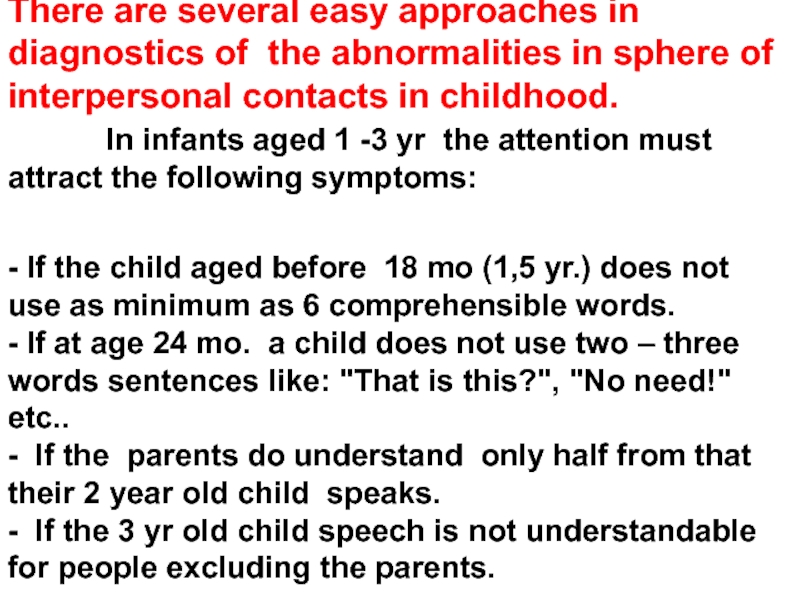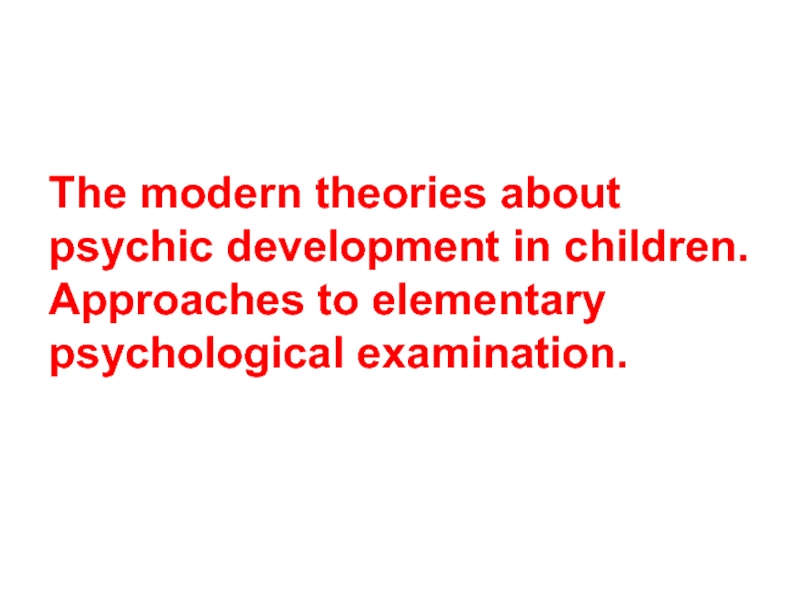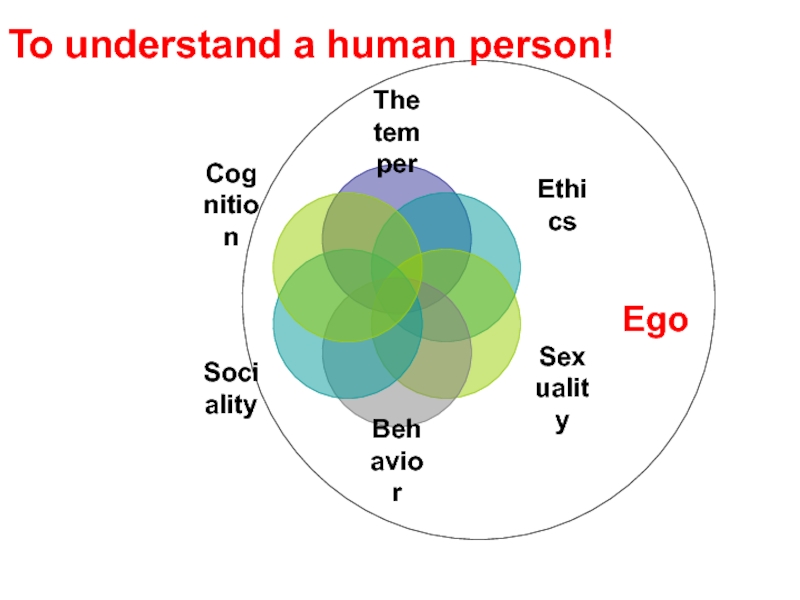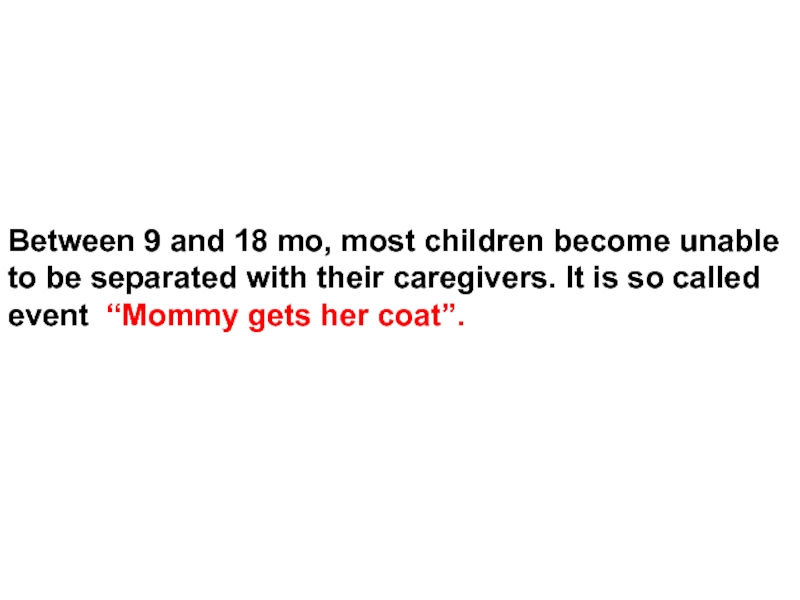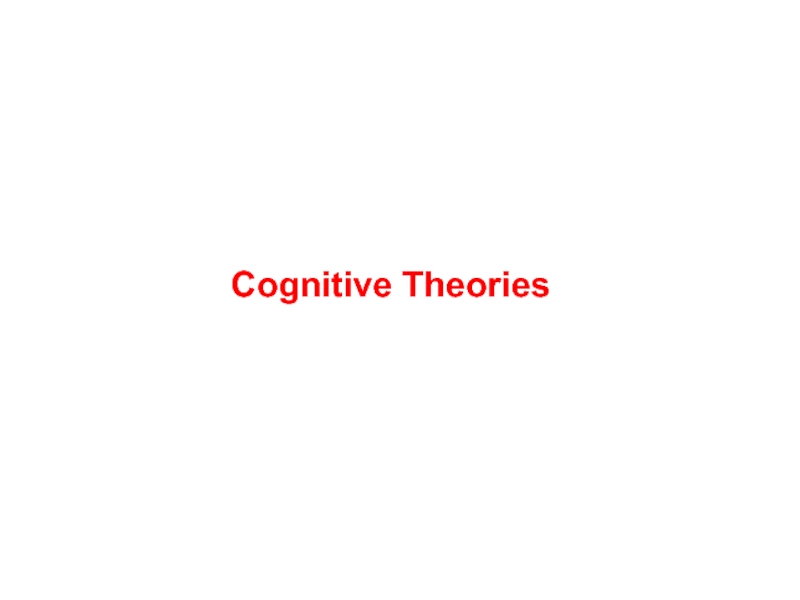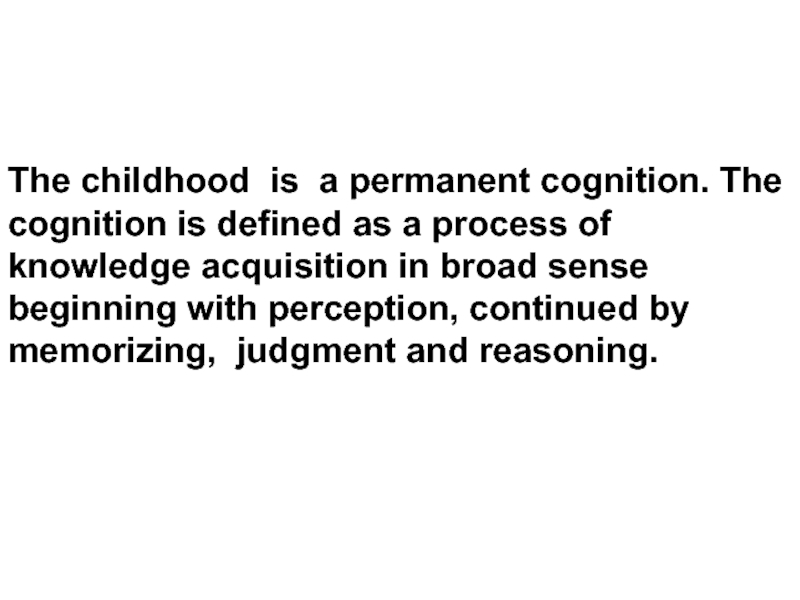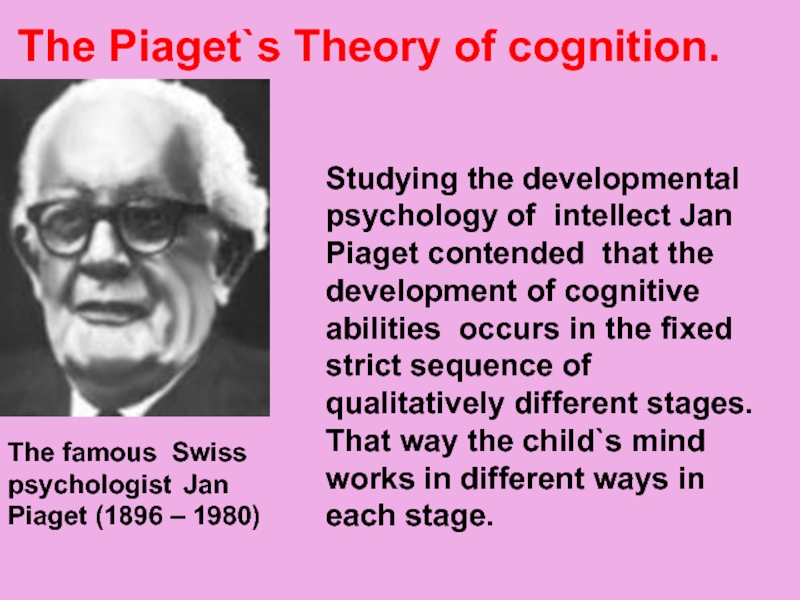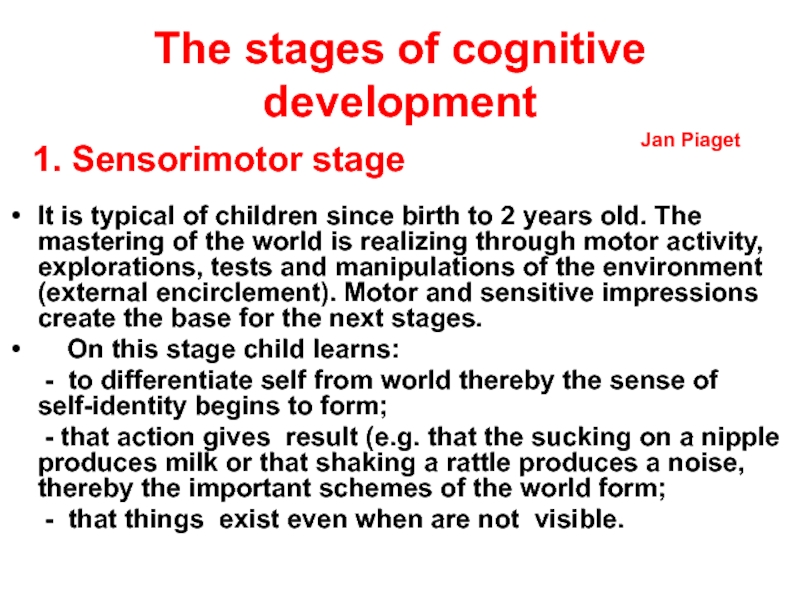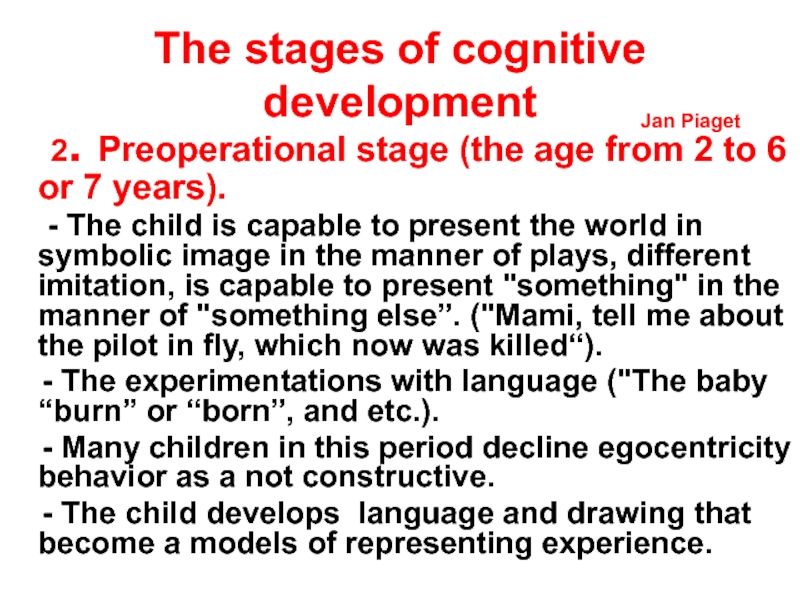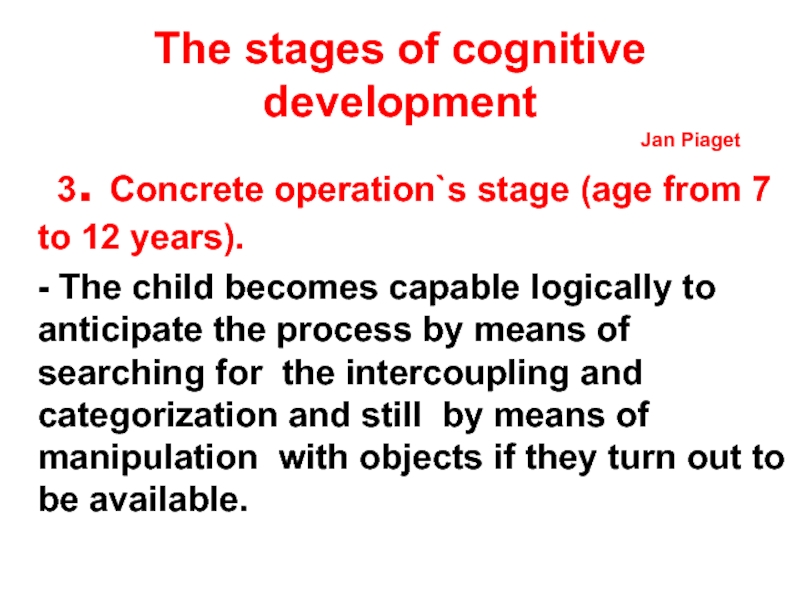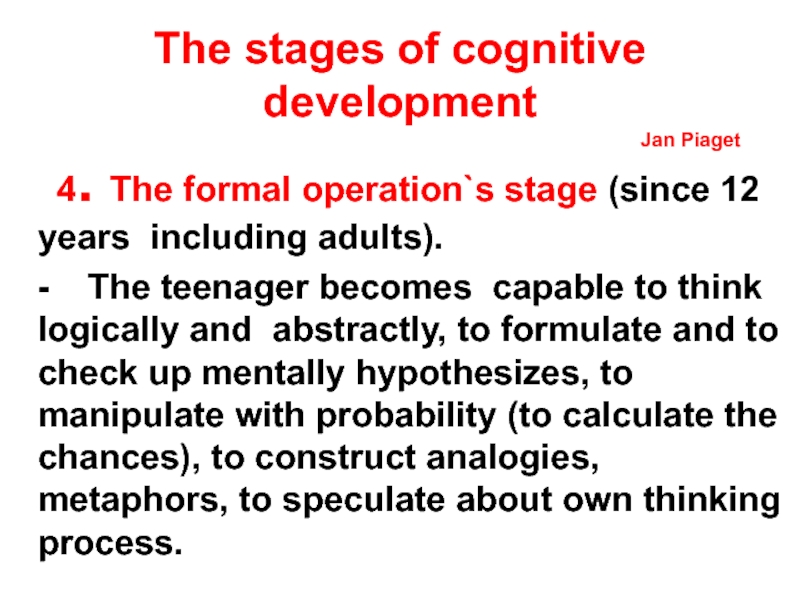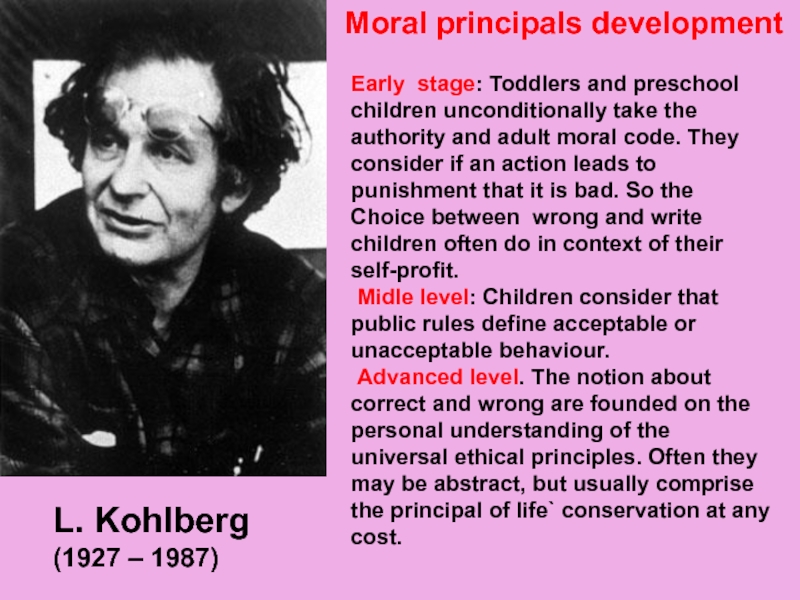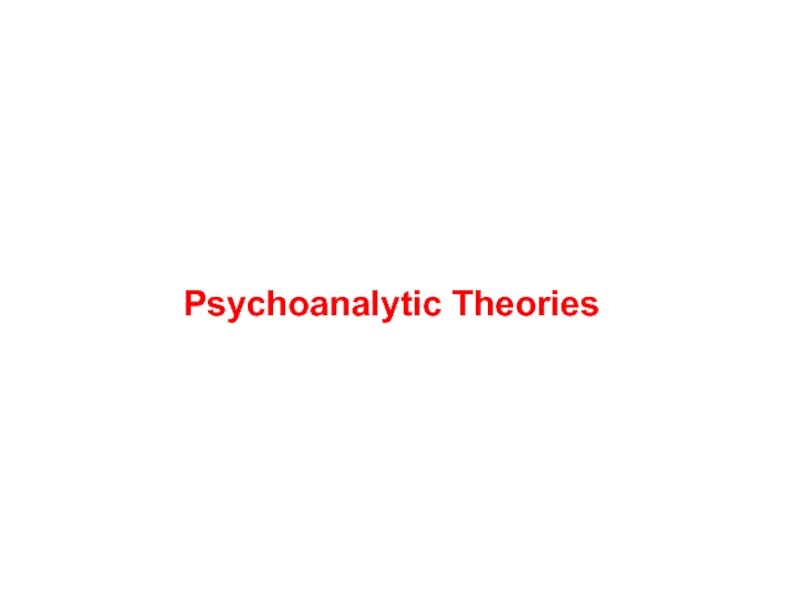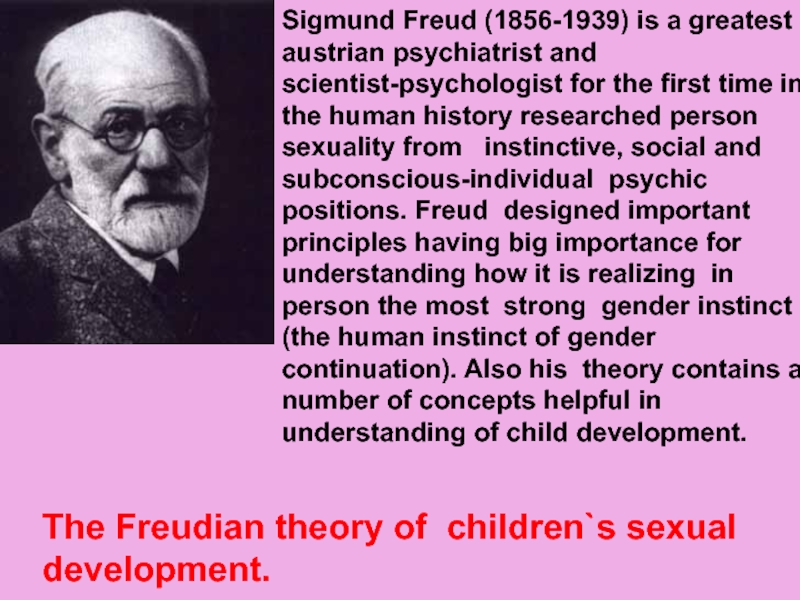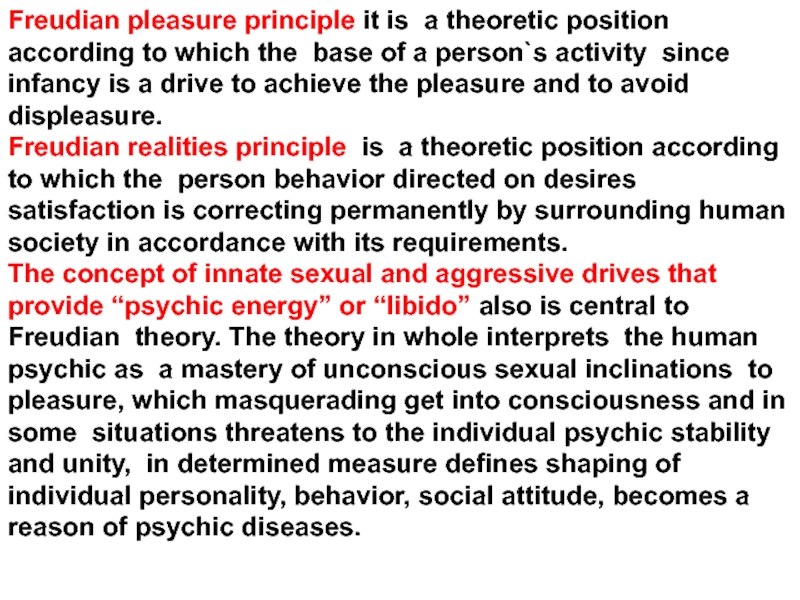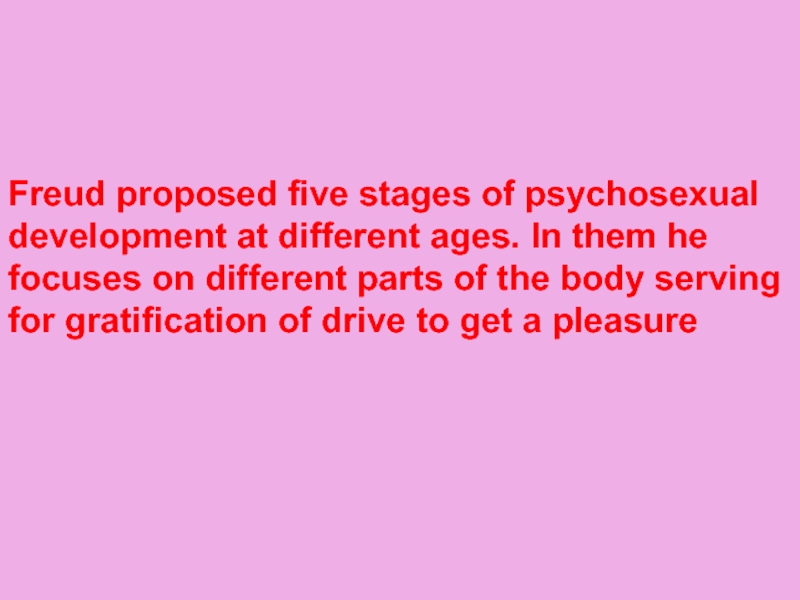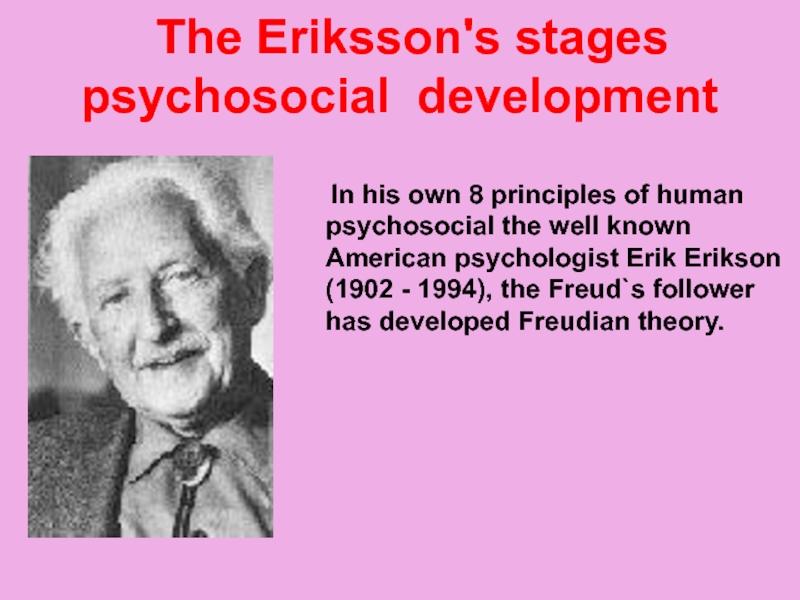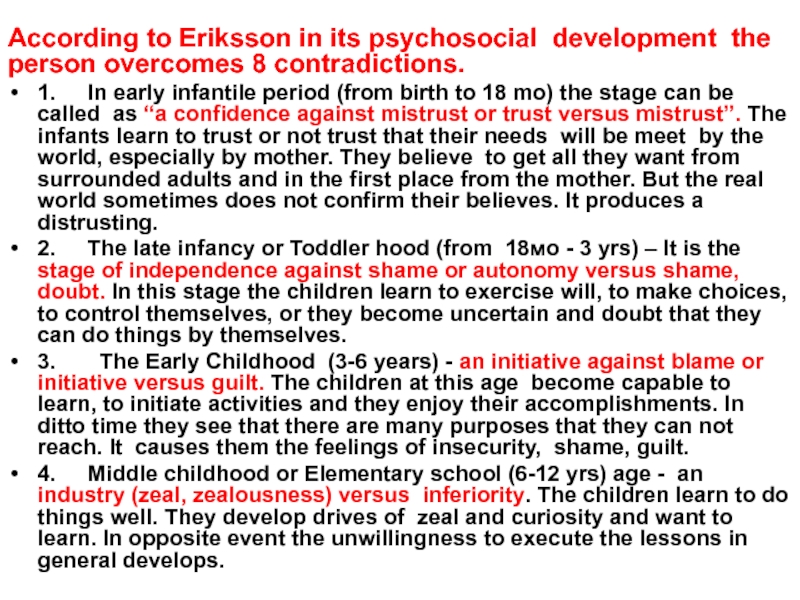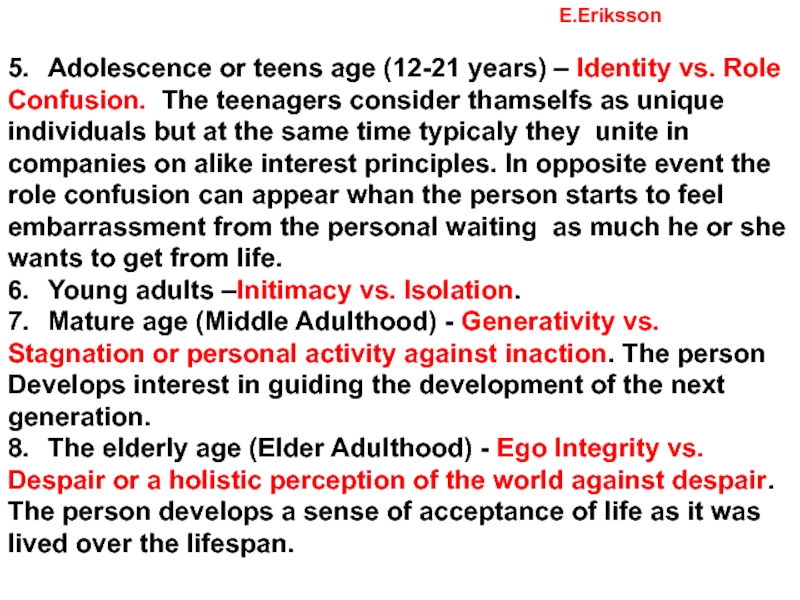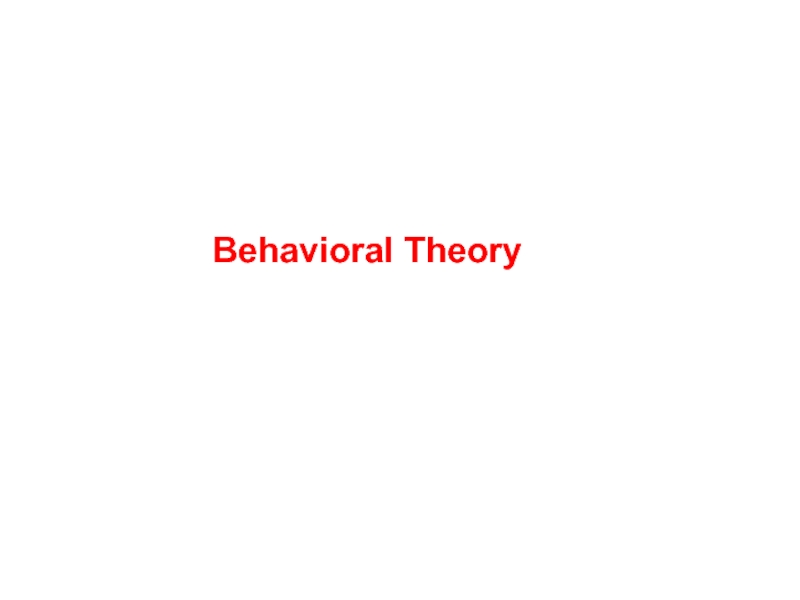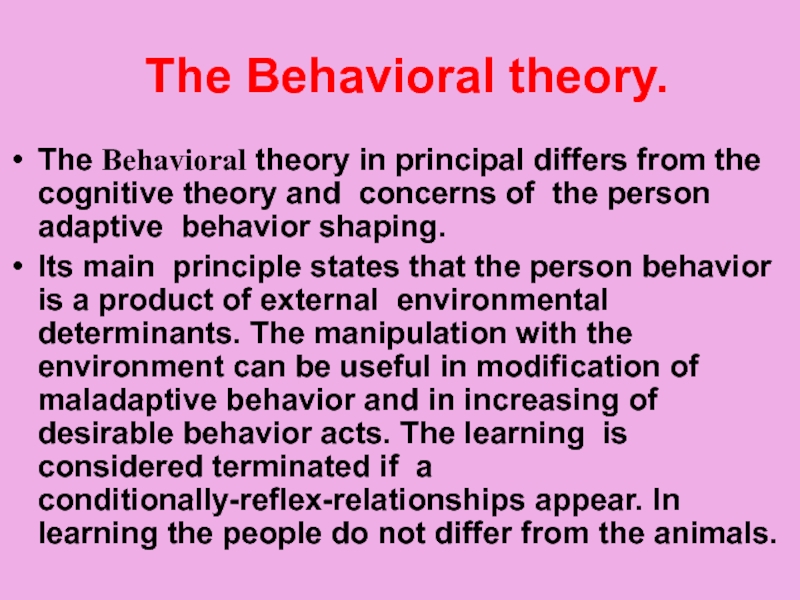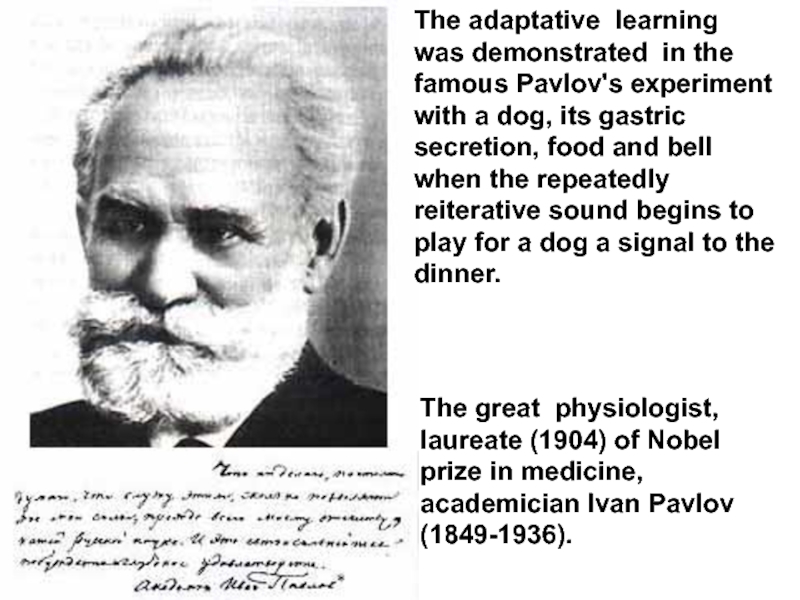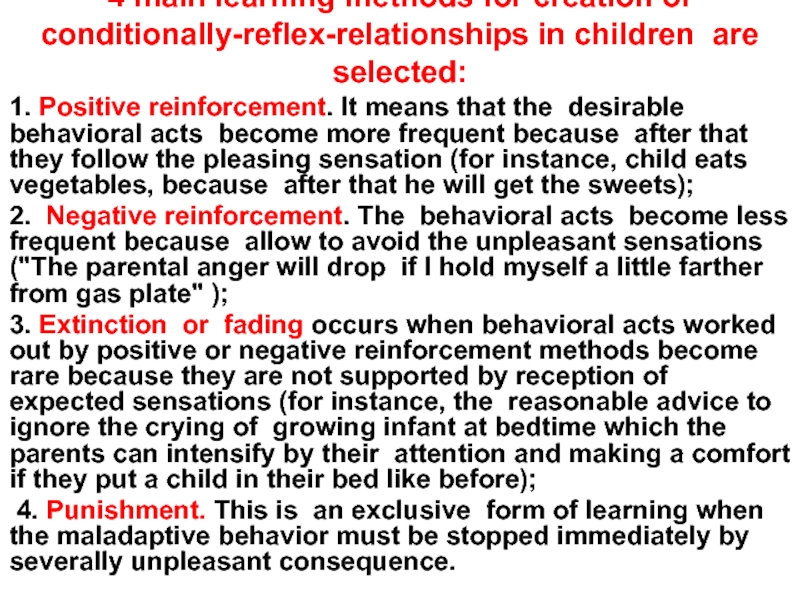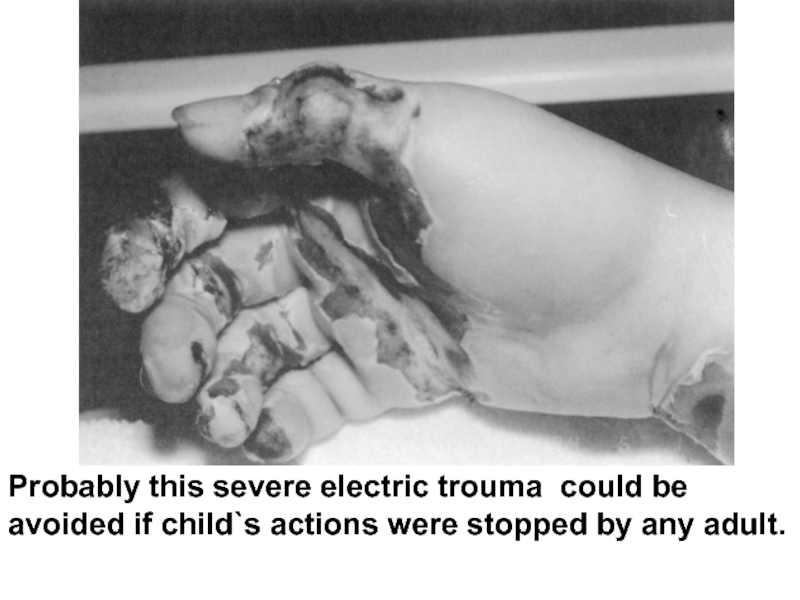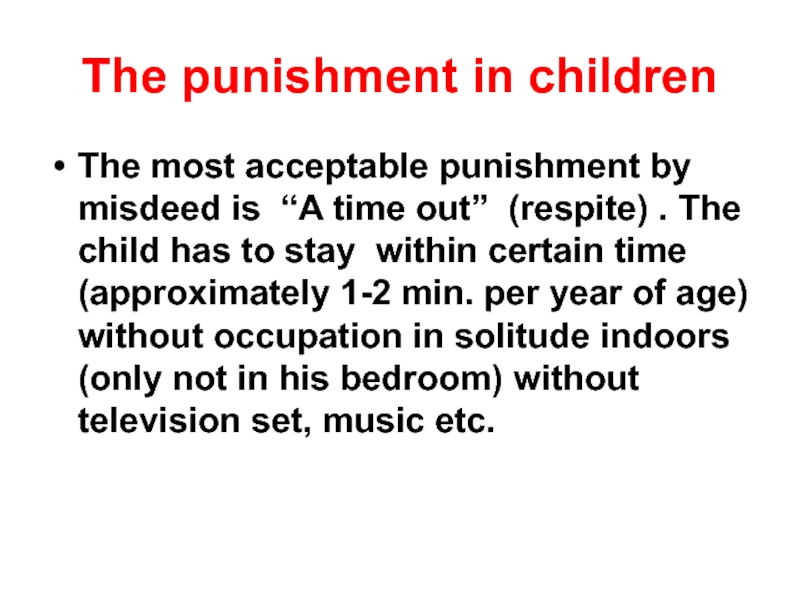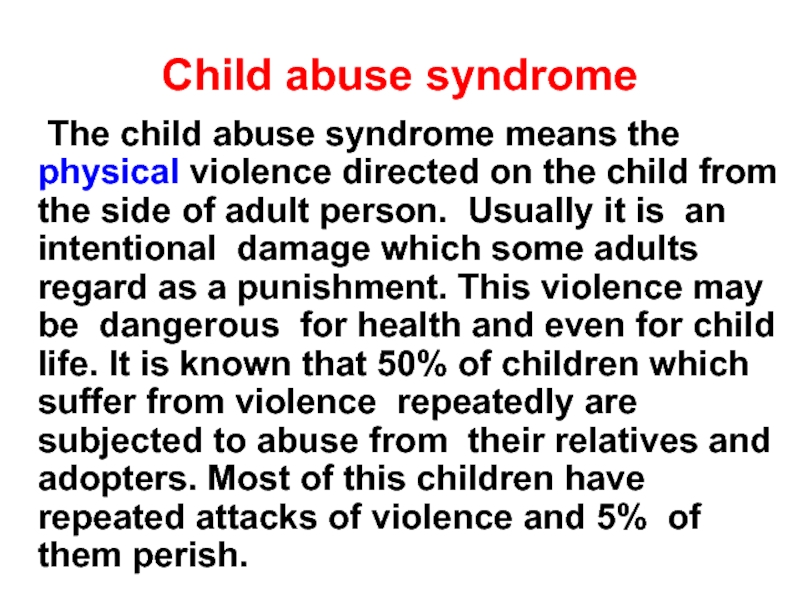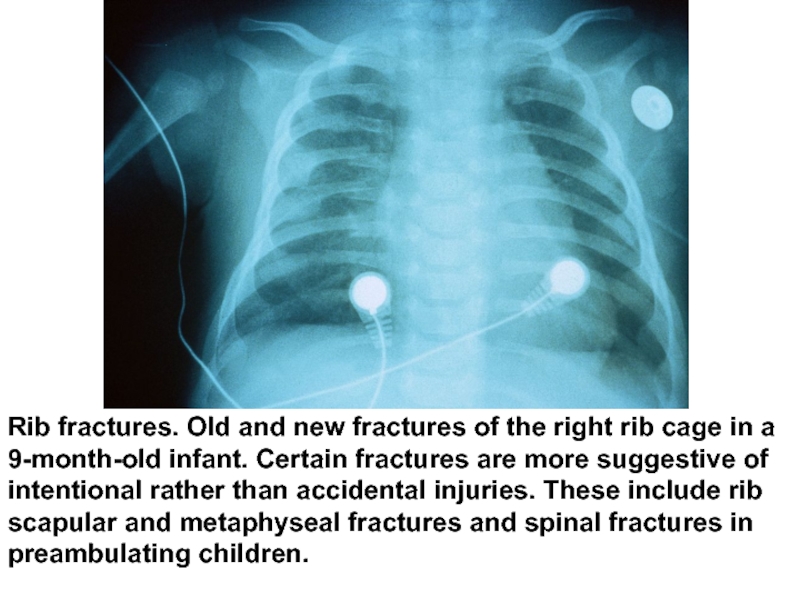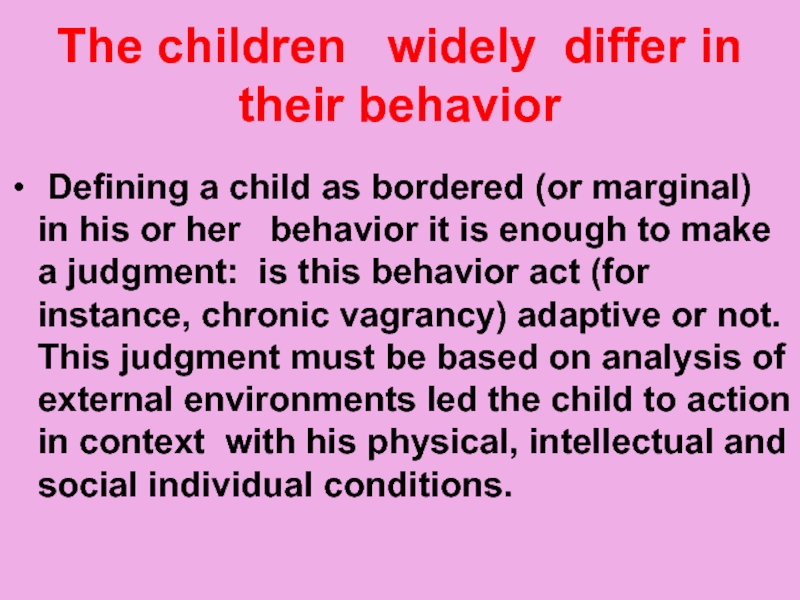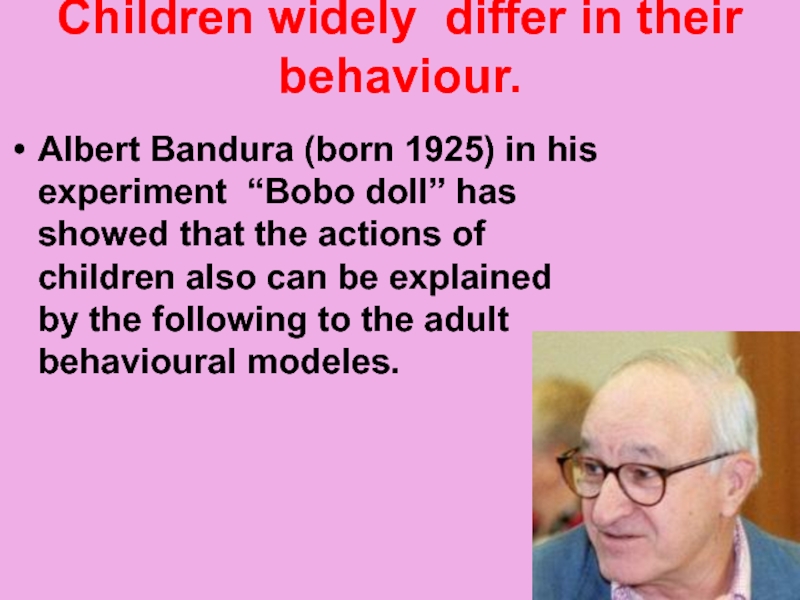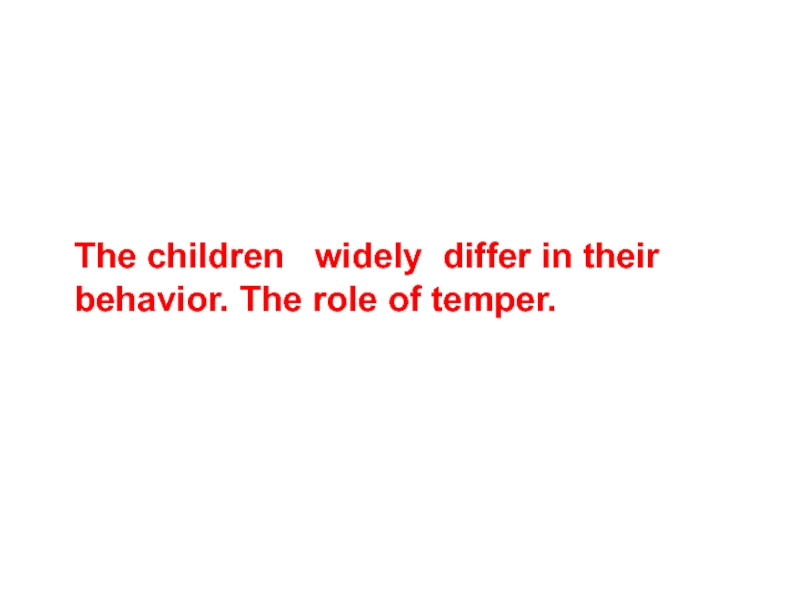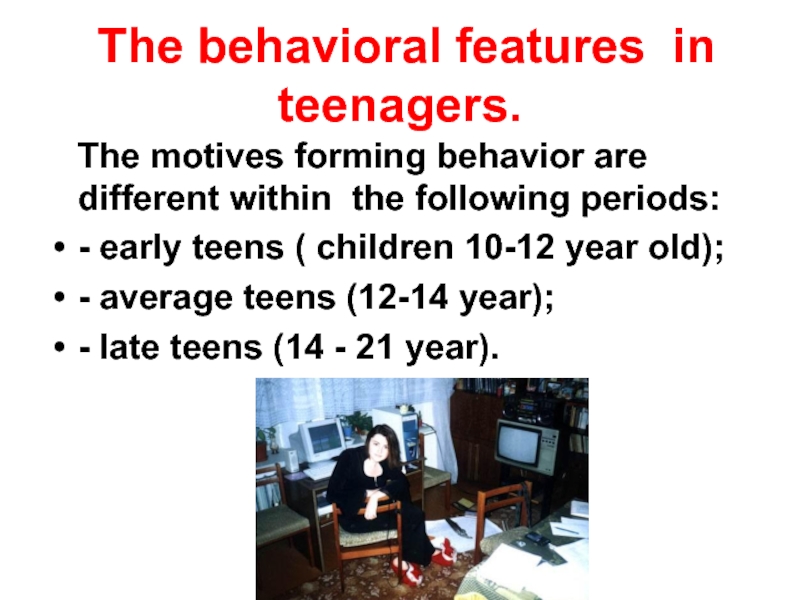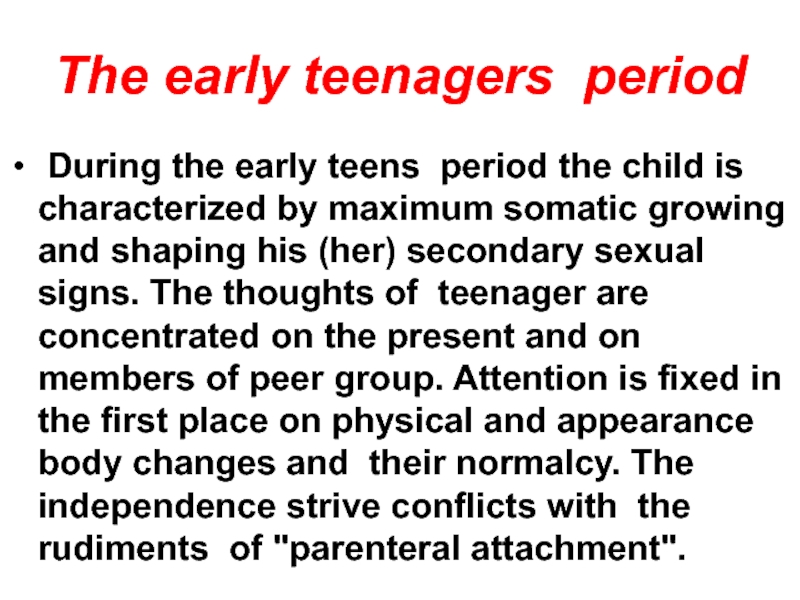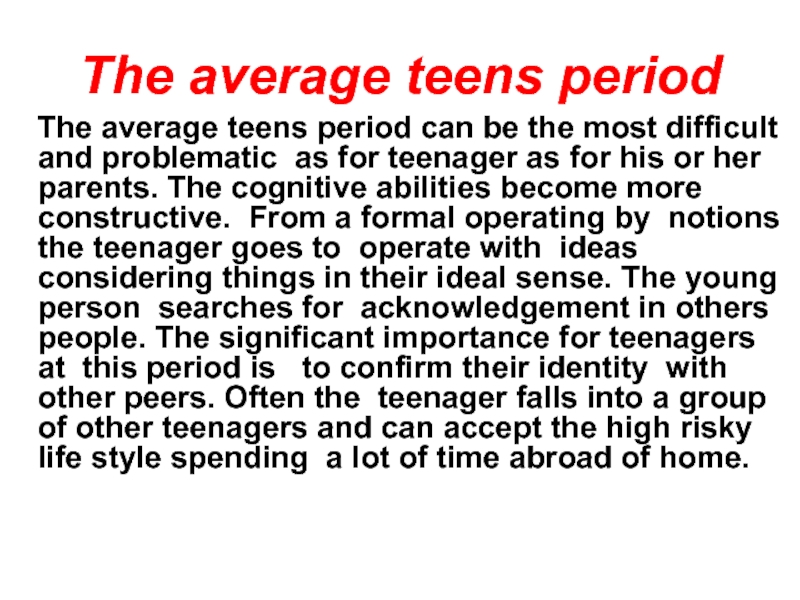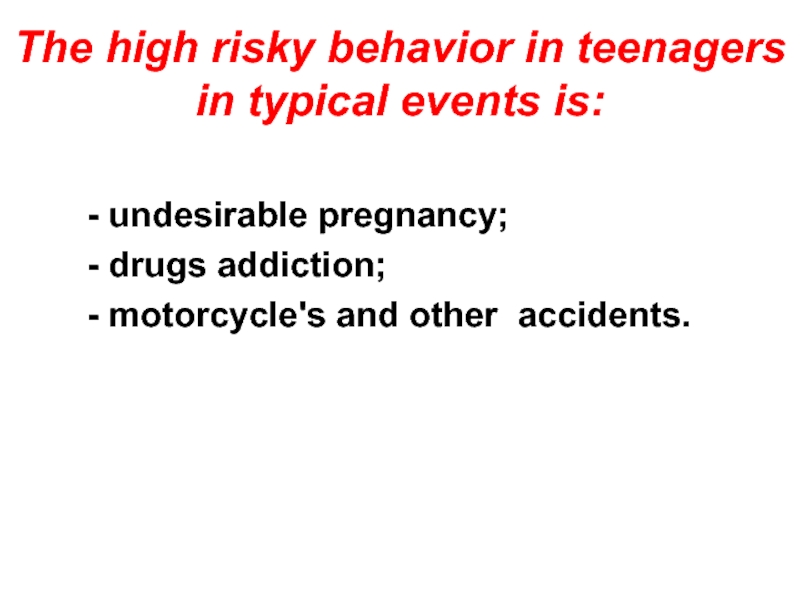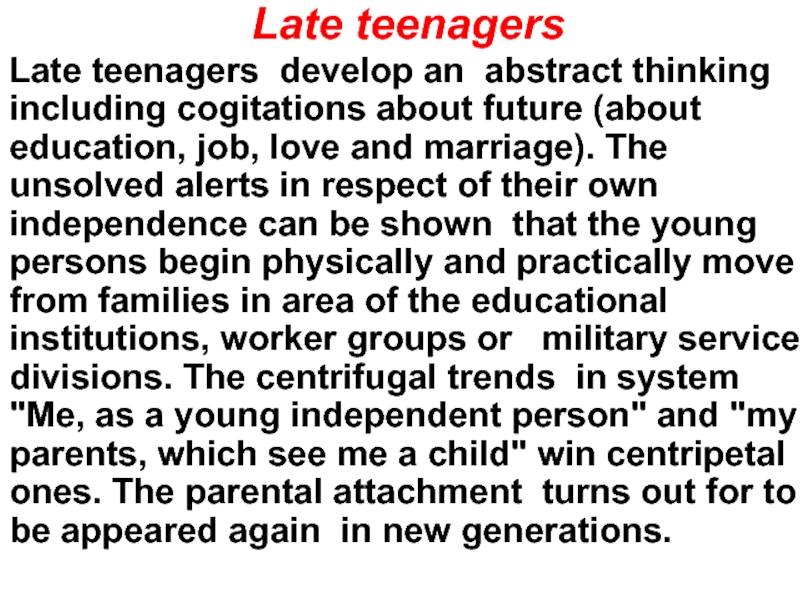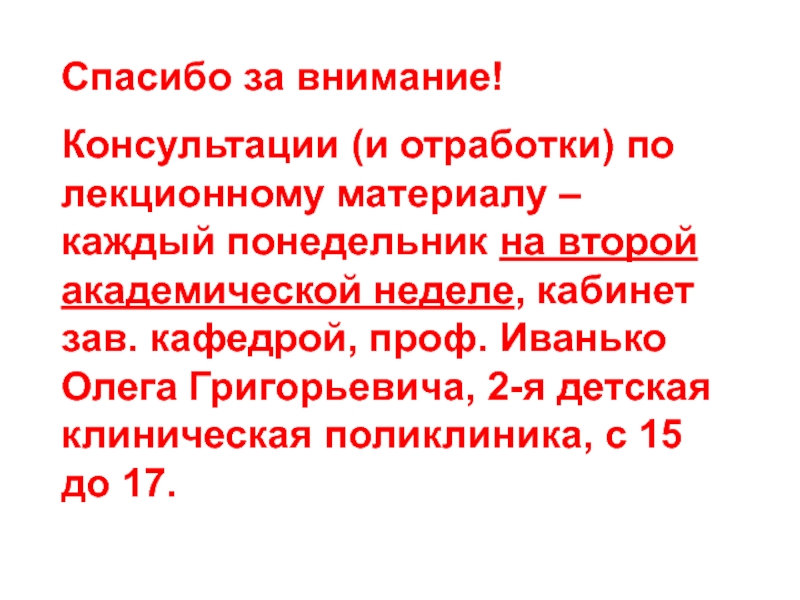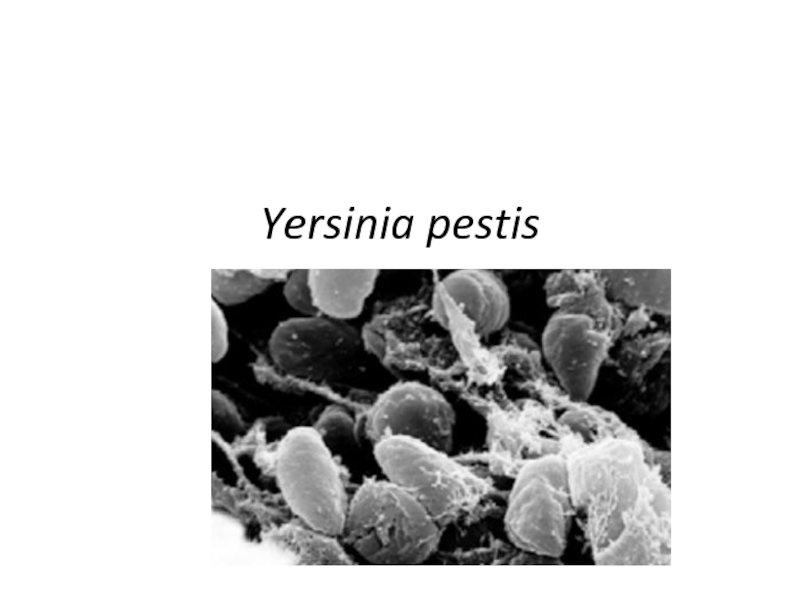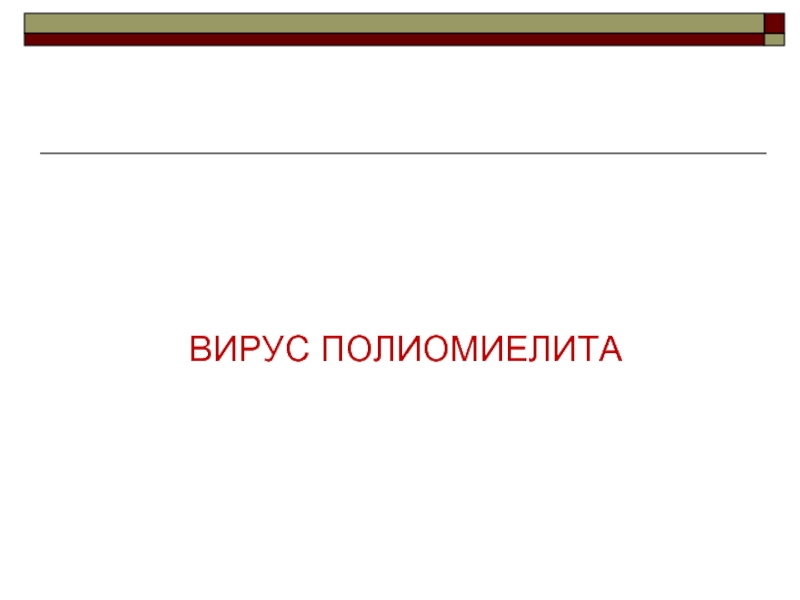1. The approaches to the psychomotor assessment in children since first months until age 6 year inclusively.
2. The semiotics of psychomotor abnormalities in children.
3. The modern theories about psychic development in children. Approaches to elementary psychological evaluation.
a) The phenomenon of bonding and attachment in young children. An Isolated child by R.Spitz.
b) Cognitive Theories: Piaget`s, Kohlberg`s
c) Psychoanalytic Theories: Freud`s, Eriksson's
d) Behavioral Theory: Pavlov's, Bandura`s
e) The role of temper in children.
- Главная
- Разное
- Дизайн
- Бизнес и предпринимательство
- Аналитика
- Образование
- Развлечения
- Красота и здоровье
- Финансы
- Государство
- Путешествия
- Спорт
- Недвижимость
- Армия
- Графика
- Культурология
- Еда и кулинария
- Лингвистика
- Английский язык
- Астрономия
- Алгебра
- Биология
- География
- Детские презентации
- Информатика
- История
- Литература
- Маркетинг
- Математика
- Медицина
- Менеджмент
- Музыка
- МХК
- Немецкий язык
- ОБЖ
- Обществознание
- Окружающий мир
- Педагогика
- Русский язык
- Технология
- Физика
- Философия
- Химия
- Шаблоны, картинки для презентаций
- Экология
- Экономика
- Юриспруденция
The medical aspects of psychic development and adaptive behavior in children презентация
Содержание
- 1. The medical aspects of psychic development and adaptive behavior in children
- 2. The medical aspects of psychic development and adaptive behavior in children.
- 3. The persistent dynamic observation of children
- 4. In condition of brain cortex
- 5. It is necessary to understand that the
- 6. The normal psychomotor development is defined
- 7. The approaches to the psychomotor assessment
- 8. The psychomotor development estimations in
- 9. All behavior skills (milestones) in child should
- 10. The Ukrainian pediatricians in their everyday
- 11. Estimating the gross motor skills (milestones)
- 12. The fine motor skills (milestones): -
- 13. The establishment of interpersonal-to-society relationships
- 14. The language development: -
- 15. Visual function evaluation in small children In
- 16. Auditory function evaluation in small children The
- 17. Denver-II-test The most accurate test system
- 19. The obtained ones upon a
- 20. 6 yr aged children have to pass
- 21. Copy
- 22. The semiotics of psychomotor abnormalities in children.
- 23. Common delay of psychomotor development The
- 24. The motor developmental delay The delay
- 25. The personal-social and language developmental delay The
- 26. There are several easy approaches in diagnostics
- 27. There are several easy approaches in diagnostics
- 28. The modern theories about psychic
- 29. Ego To understand a human person!
- 30. The phenomenon of bonding and attachment in
- 31. Between
- 32. Isolated child The hospitalism
- 33. Cognitive Theories
- 34. The childhood is a permanent cognition. The
- 35. The Piaget`s Theory of cognition.
- 36. The stages of cognitive development
- 37. The stages of cognitive development
- 38. The stages of cognitive development
- 39. The stages of cognitive development
- 40. Moral principals development L.
- 41. Psychoanalytic Theories
- 43. Freudian pleasure principle it is a theoretic
- 44. Freud proposed five stages of psychosexual development
- 45. I. The age 0 - 18 mo.
- 46. The Freudian genius has found the roots
- 47. The Eriksson's stages psychosocial development
- 48. 1. In early infantile period (from birth to
- 49. 5. Adolescence or teens age (12-21 years) –
- 50. Behavioral Theory
- 51. The Behavioral theory. The Behavioral
- 52. The adaptative learning was demonstrated in the
- 53. 4 main learning methods for creation
- 54. Probably this severe electric trouma could be
- 55. The punishment in children The most acceptable
- 56. The conditions related with learning mistakes. Often
- 57. Child abuse syndrome The child
- 58. А. Hand mark on the buttocks of
- 60. Rib fractures. Old and new fractures of
- 61. The children widely differ in their
- 62. Children widely differ in their behaviour.
- 63. The children widely differ in their behavior. The role of temper.
- 64. The children widely differ in their
- 65. The behavioral features in teenagers.
- 66. The early teenagers period During
- 67. The average teens period
- 68. The high risky behavior in teenagers in
- 69. Late teenagers Late teenagers develop
- 70. Спасибо за внимание! Консультации (и отработки) по
Слайд 1Background of the lecture: The medical aspects of psychic development and
Слайд 3
The persistent dynamic observation of children for their motor, psychic and
Слайд 4 In condition of brain cortex maturation for period since
Слайд 5It is necessary to understand that the normal psychomotor development as
Слайд 6 The normal psychomotor development is defined by making to a
- the child must be physically well;
- presence of parents or persons capable to express toward a child true feeling of attachment ;
- a normal care, feeding and education
- safety of the most important organ feeling: a vision and a hearing.
Слайд 7 The approaches to the psychomotor assessment in children since first
Слайд 8 The psychomotor development estimations in young children are executed
Слайд 9All behavior skills (milestones) in child should be group up into
- gross (general) motor, including steady-state skills (milestones) when a child adapts to gravitation (to the earth attraction);
personal-social ("Me and society“)
language (speech shaping)
a fine motor milestones (adaptive).
Also the visual and hearing sensation must be tested.
Слайд 10 The Ukrainian pediatricians in their everyday clinical practice use the
Слайд 11 Estimating the gross motor skills (milestones) the following standard sequence
to keep a head up (set-head steady). The normal answer is "at age 2 months” (50-th percentile);
to get sitting (at 6 mo);
to stand up alone (at 10 mo);
- to walk well (at age 1 year).
Слайд 12The fine motor skills (milestones):
- to follow up the objects by
- to turn over in bed the child begins at 4 months;
- to manipulate with toys (rattles) at 6 mo;
- to rise on stair a child begins since 1,5 years approximately.
Слайд 13The establishment of interpersonal-to-society relationships
- to smile spontaneously at age
- to smile contacting with mother at age 3 mo;
- to be scared with strangers (including a medical stuff) at 7 mo.
Слайд 14The language development:
- to talk "ooo/aah” – the dove (pigeon)
- to prattle (“soueals” words) at age 6 mo;
- to pronounce a first intelligent words (“dana/mama”) at 1 yr.
- to speech a first simple sentences at 2 yr.
Слайд 15Visual function evaluation in small children
In newborns the visual function is
The light exposition in a sleeping child makes his eyes more closed. In a small baby with opened eyes the sudden light provokes blinking and avoiding reaction.
The children older 2 months of age can follow the flashlight by eyes if it is situated on distance of 30 cm.
Слайд 16Auditory function evaluation in small children
The response to the loud sound
Children older 2 months demonstrate the response to palms pat on distance of 30-40 cm from the head with blinking or eyes close.
Since 3 months of age children begin to turn the head towards the sound of toy which they do not see.
Слайд 17Denver-II-test
The most accurate test system is presented in worldwide used
and personal – social.
Слайд 206 yr aged children have to pass developmental test on school
The test is executed by school teachers or school psychologists and detects an intellectual level (IQ), a level of hand (manual) abilities to write and to draw, to copy etc. As a practice the examiners ask a child to draw liberally a figure of person which must have schematically all 6 main human components (head, hands, legs etc).
Слайд 23Common delay of psychomotor development
The backlog (retardation) on shaping of
Слайд 24The motor developmental delay
The delay only in motor development is
Слайд 25The personal-social and language developmental delay
The abnormalities of personal-social and language
Слайд 26There are several easy approaches in diagnostics of the abnormalities in
- a child aged before 6 mo does not scare, blink or change immediately its activities in response to sudden loud sound;
- a child aged before 6 mo is not interesting by human speech, does not quiet down in response to mother voice;
- a child aged before 6 mo. does not pronounce “ooo/aah” and prattle;
- a child aged before 10 mo. does not react on his or her name;
- a child aged before 12 mo. pronounces only sounds which are limited only by wail, moan or long vowels.
Слайд 27There are several easy approaches in diagnostics of the abnormalities in
- If the child aged before 18 mo (1,5 yr.) does not use as minimum as 6 comprehensible words.
- If at age 24 mo. a child does not use two – three words sentences like: "That is this?", "No need!" etc..
- If the parents do understand only half from that their 2 year old child speaks.
- If the 3 yr old child speech is not understandable for people excluding the parents.
Слайд 28
The modern theories about psychic development in children. Approaches to
Слайд 30The phenomenon of bonding and attachment in young children.
The bonding (Tie) usually appears immediately after birth and reflects the positive feeling of the parents toward the newborn. This fillings are unidirectional.
The attachment involves reciprocal feelings between parents and infant and develops gradually within the first year. The effective bonding in the postpartum (post delivery) period may enhance the development of attachment. The medical staff has to help the bonding and attachment shaping providing early nursing with skin to skin mother-to-child contact and the father presence in delivery room. In these condition the bonding of the parents to child is formed early and more intensively.
Слайд 31
Between 9 and 18 mo, most children become unable to
Слайд 32Isolated child
The hospitalism is a synonym of condition
R. Spitz
(1887 – 1974)
Слайд 34The childhood is a permanent cognition. The cognition is defined as
Слайд 35The Piaget`s Theory of cognition.
The famous Swiss psychologist Jan Piaget
Studying the developmental psychology of intellect Jan Piaget contended that the development of cognitive abilities occurs in the fixed strict sequence of qualitatively different stages. That way the child`s mind works in different ways in each stage.
Слайд 36The stages of cognitive development
1. Sensorimotor stage
It
On this stage child learns:
- to differentiate self from world thereby the sense of self-identity begins to form;
- that action gives result (e.g. that the sucking on a nipple produces milk or that shaking a rattle produces a noise, thereby the important schemes of the world form;
- that things exist even when are not visible.
Jan Piaget
Слайд 37The stages of cognitive development
2. Preoperational stage (the
- The child is capable to present the world in symbolic image in the manner of plays, different imitation, is capable to present "something" in the manner of "something else”. ("Mami, tell me about the pilot in fly, which now was killed“).
- The experimentations with language ("The baby “burn” or “born”, and etc.).
- Many children in this period decline egocentricity behavior as a not constructive.
- The child develops language and drawing that become a models of representing experience.
Jan Piaget
Слайд 38The stages of cognitive development
3. Concrete operation`s stage
- The child becomes capable logically to anticipate the process by means of searching for the intercoupling and categorization and still by means of manipulation with objects if they turn out to be available.
Jan Piaget
Слайд 39The stages of cognitive development
4. The formal operation`s
- The teenager becomes capable to think logically and abstractly, to formulate and to check up mentally hypothesizes, to manipulate with probability (to calculate the chances), to construct analogies, metaphors, to speculate about own thinking process.
Jan Piaget
Слайд 40
Moral principals development
L. Kohlberg
(1927 – 1987)
Early stage:
Midle level: Children consider that public rules define acceptable or unacceptable behaviour.
Advanced level. The notion about correct and wrong are founded on the personal understanding of the universal ethical principles. Often they may be abstract, but usually comprise the principal of life` conservation at any cost.
Слайд 42
The Freudian theory of children`s sexual
development.
Sigmund Freud (1856-1939) is a
Слайд 43Freudian pleasure principle it is a theoretic position according to which
Freudian realities principle is a theoretic position according to which the person behavior directed on desires satisfaction is correcting permanently by surrounding human society in accordance with its requirements.
The concept of innate sexual and aggressive drives that provide “psychic energy” or “libido” also is central to Freudian theory. The theory in whole interprets the human psychic as a mastery of unconscious sexual inclinations to pleasure, which masquerading get into consciousness and in some situations threatens to the individual psychic stability and unity, in determined measure defines shaping of individual personality, behavior, social attitude, becomes a reason of psychic diseases.
Слайд 44Freud proposed five stages of psychosexual development at different ages. In
Слайд 45
I. The age 0 - 18 mo. – an oral stage. The
II. The age 18мo – 3yr - an anal stage – Children obtain gratification (a pleasure) through exercise the anal musculature during elimination or retention. It means that children exercise to restrain or pass stools by volitional effort and are supported by the mother if they are succesfull.
III. The age 3-6 years - a phallic stage (or the stage of Oedipal complex shaping). In this stage it is absolutely normal if the children develop sexual curiosity. They have sexual fantasies about the parent of the opposite sex and feel guilt about their fantasies.
IV. The age 6-12 years - a latency stage. – Children`s sexual urges are submerged. They put their energies into acquiring cultural skills and are occupied with the common social knowledge acquisition.
V. The age from nearly 12 years until adultness – the genital stage. The teenagers gradually form adult heterosexual desires and seek to satisfy them (search for reciprocity).
.
S.Freud
Слайд 46The Freudian genius has found the roots of adult psychic problems
Are you a heavy smoker?
Слайд 47 The Eriksson's stages psychosocial development
In his own 8
Слайд 481. In early infantile period (from birth to 18 mo) the stage
2. The late infancy or Toddler hood (from 18мo - 3 yrs) – It is the stage of independence against shame or autonomy versus shame, doubt. In this stage the children learn to exercise will, to make choices, to control themselves, or they become uncertain and doubt that they can do things by themselves.
3. The Early Childhood (3-6 years) - an initiative against blame or initiative versus guilt. The children at this age become capable to learn, to initiate activities and they enjoy their accomplishments. In ditto time they see that there are many purposes that they can not reach. It causes them the feelings of insecurity, shame, guilt.
4. Middle childhood or Elementary school (6-12 yrs) age - an industry (zeal, zealousness) versus inferiority. The children learn to do things well. They develop drives of zeal and curiosity and want to learn. In opposite event the unwillingness to execute the lessons in general develops.
According to Eriksson in its psychosocial development the person overcomes 8 contradictions.
Слайд 495. Adolescence or teens age (12-21 years) – Identity vs. Role Confusion.
6. Young adults –Initimacy vs. Isolation.
7. Mature age (Middle Adulthood) - Generativity vs. Stagnation or personal activity against inaction. The person Develops interest in guiding the development of the next generation.
8. The elderly age (Elder Adulthood) - Ego Integrity vs. Despair or a holistic perception of the world against despair. The person develops a sense of acceptance of life as it was lived over the lifespan.
E.Eriksson
Слайд 51 The Behavioral theory.
The Behavioral theory in principal differs from
Its main principle states that the person behavior is a product of external environmental determinants. The manipulation with the environment can be useful in modification of maladaptive behavior and in increasing of desirable behavior acts. The learning is considered terminated if a conditionally-reflex-relationships appear. In learning the people do not differ from the animals.
Слайд 52The adaptative learning was demonstrated in the famous Pavlov's experiment with
The great physiologist, laureate (1904) of Nobel prize in medicine, academician Ivan Pavlov (1849-1936).
Слайд 53 4 main learning methods for creation of conditionally-reflex-relationships in children are
1. Positive reinforcement. It means that the desirable behavioral acts become more frequent because after that they follow the pleasing sensation (for instance, child eats vegetables, because after that he will get the sweets);
2. Negative reinforcement. The behavioral acts become less frequent because allow to avoid the unpleasant sensations ("The parental anger will drop if I hold myself a little farther from gas plate" );
3. Extinction or fading occurs when behavioral acts worked out by positive or negative reinforcement methods become rare because they are not supported by reception of expected sensations (for instance, the reasonable advice to ignore the crying of growing infant at bedtime which the parents can intensify by their attention and making a comfort if they put a child in their bed like before);
4. Punishment. This is an exclusive form of learning when the maladaptive behavior must be stopped immediately by severally unpleasant consequence.
Слайд 54Probably this severe electric trouma could be avoided if child`s actions
Слайд 55The punishment in children
The most acceptable punishment by misdeed is “A
Слайд 56The conditions related with learning mistakes.
Often the behavioural deviations (so called
Слайд 57Child abuse syndrome
The child abuse syndrome means the physical
Слайд 58А. Hand mark on the buttocks of a 6-month-old infant. The
В. Marks from impact with a coathanger. A coathanger, wire, or electric cord causes contusions and lacerations. An electric cord leaves a narrower-diameter loop mark.
С. Impact from belt buckle.
А.
В.
С.
Слайд 60Rib fractures. Old and new fractures of the right rib cage
Слайд 61The children widely differ in their behavior
Defining a
Слайд 62Children widely differ in their behaviour.
Albert Bandura (born 1925) in his
Слайд 64The children widely differ in their behavior. The behavioral style
1. “Easy" children (40% in population) are characterized by regularity of biological functions. There are a constant, regular mealtime and stable bedtime. For children of this group are typical the positive reactions to new and constant positive mood. (Sanguine)
2. "Difficult" children (10% in population) differ from others by irregularity of physiological functions, by negative reactions to new and avoiding of new stimulus and mainly negative background of the mood. Typically they are a melancholic persons.
3. "Slow" children (15% in population) are characterized by low level of activities, by usual desire to escape from new impressions and as a whole by gloomy (non-fun) background of the mood. (They are a group of phlegmatic).
4. The rest of children pertains to the mixed behavioral group.
Слайд 65 The behavioral features in teenagers.
The motives forming behavior
- early teens ( children 10-12 year old);
- average teens (12-14 year);
- late teens (14 - 21 year).
Слайд 66The early teenagers period
During the early teens period the
Слайд 67The average teens period
The average teens period can
Слайд 68The high risky behavior in teenagers in typical events is:
- undesirable pregnancy;
- drugs addiction;
- motorcycle's and other accidents.
